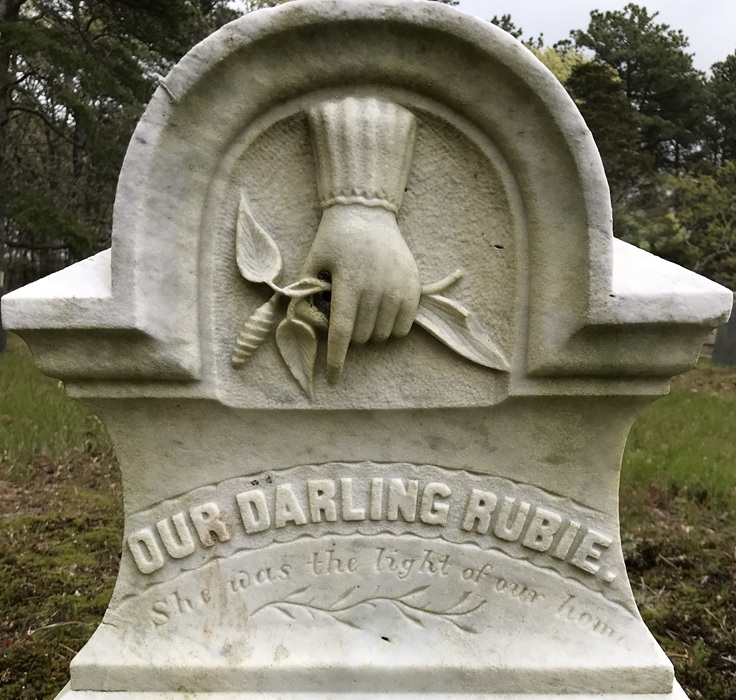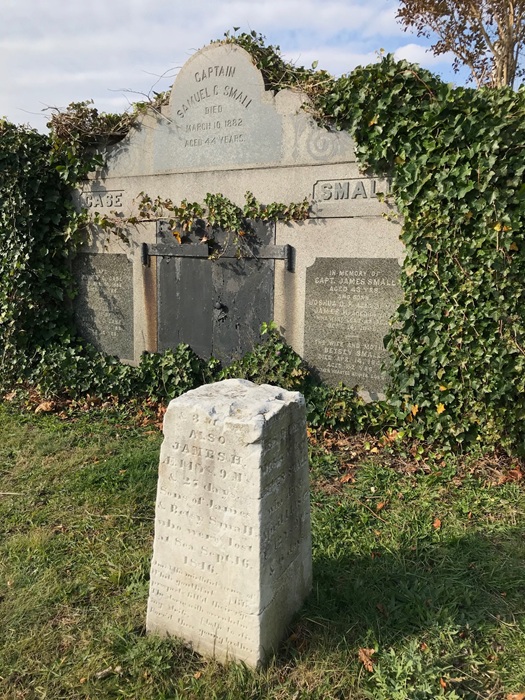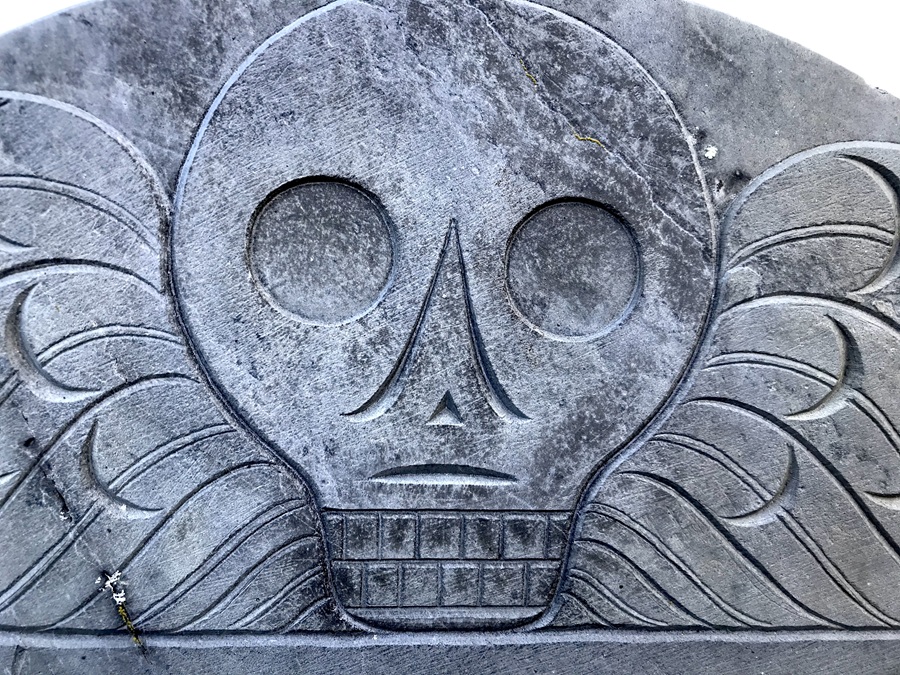It will come as no surprise to readers that for this “Graveyard Shift” column and for other research, I spend considerable time in old cemeteries. They have much to recommend them, not the least being a peace and quiet that fosters reflection and perspective. Many old cemeteries, tucked away as they are on the edges of towns where long-departed meetinghouses once stood, provide an off-the-beaten-path experience, an escape from the bustle of busy tourist areas.
Historic cemeteries also offer exquisite examples of gravestone art, from the austere colonial iconography to the sentimentality of Victorian statuary. Each motif has meaning and is a portal into how past generations viewed the here and now and the afterlife.
What these places convey to me is that the departed have unique stories to tell. Sometimes these are hinted at by an inscription or poignant epitaph or by a unique and personal grave marker. Others are enigmas, the graves offering little more than a name and two dates, leaving a visitor to wonder and imagine the history they represent.

My wanderings have impressed upon me that in too many places, older cemeteries are in dire need of advocates and care. Stones are broken, sunken, toppled, obscured by growth, encrusted with lichen and grime, and eroded by the elements. In some cases, once-elegant monuments and enclosures have been cavalierly discarded. I can’t say how routinely this desecration has occurred, but, in too many instances, cemetery superintendents tell me that behind their maintenance sheds they have piles of unidentifiable, unrepatriated headstone pieces, chunks that have been victims of vandals or clunky mowing machines. There have even been times when the stones, after being unclaimed for too long, have been used where needed, as if they were ordinary rocks.
In 2013, one such instance came into view, and things were made right. Just when a whaling exhibit was being prepared for the Pilgrim Monument and Provincetown Museum, a broken marble monument was “discovered” in the newer cremation lot of the Provincetown Cemetery, apparently placed there as a decoration after it had been rescued from behind the maintenance garage.
But that’s not the whole story. In 1983, the same marble, then being used as fill, had been unearthed by construction workers replacing tanks under a gas station in the middle of downtown. At the time, one of Provincetown’s historians told a newspaper reporter that she was aware of “a lot of extra gravestones in town” and that she knew of tombstones that had been used to support houses.
As for the marble stone in question, it was inscribed with the heartbreaking family story of Capt. James Small and his two sons, lost at sea aboard the whaling brig Rienzi in 1846, and their wife and mother, Betsy, who died “broken hearted at her loss.”

Courtesy of the Provincetown Cemetery Commission, the rescued stone was displayed during the whaling exhibit and then was returned to its rightful place at the Small family plot. How something so substantial and with an inscription that was clearly legible went missing from the family tomb and remained apart from it for decades remains a mystery.
This was certainly an unusual incident, but still, it’s a distressing one for those of us who think of cemeteries as sacred spaces, rooted in memory, and undeserving of the day-to-day indifference too often paid to other public spaces.
Even objects made of stone need attention, care, and maintenance, though when community resources are stretched thin trying to take care of the living, it can be a hard sell to earmark funds for old cemeteries where graves have long been ignored and where the stories they could tell have turned to dust.
Most of the cemeteries that have been described in this column over the years have lately been blessed with proactive commissions that are pursuing caretaking and awareness initiatives. Headstones, cleaned and reset, have been restored by resident “angels” to their original decorative beauty, dignity, and legibility. Annual cleanup days clear away brush and trash. Resources such as plot plans that enhance the experience of visiting the cemeteries are available on town websites.
The Truro Cemetery Commission has recently published a field guide, now in its second printing. Provincetown published a guide in 2017, and Wellfleet and Eastham both have published inscriptions for selected cemeteries. Eastham has employed ground penetrating radar to document graves whose stones have been lost. The Wellfleet Historical Society is offering graveyard tours as has Truro in the past. Provincetown has ambitious plans for a digital experience, guided by GPS with QR codes. Towns are applying for community preservation grants and exploring ideas to create nonprofit “friends of the cemetery” organizations.

These efforts suggest that the historic cemeteries on the Outer Cape could be marketed — dare I use the word? — as worthy of attention. They will never be the well-endowed places of pilgrimage like Mt. Auburn in Cambridge, Cimetière du Père-Lachaise in Paris, or Green-Wood in Brooklyn that have become bona fide must-see attractions for tombstone tourists, enticing visitors with their rich and famous residents and literary and artistic programming, but they have their own fascinating stories that offer perspective and deep history.
Some years ago, as part of an effort to mark eight Revolutionary War patriot graves in Provincetown, I experienced something that has been seared ever since into my memory. Our ceremony to honor these patriots included participation by the Wareham Minutemen and Militia Company. Eight costumed members of the group dispersed themselves in the Winthrop Street Cemetery, each taking up a position next to one of the slate headstones that was being marked by the DAR. It was an intermittently stormy day, and during the ceremony, clouds swirled and fog seeped up and over the sand hills, through the pitch pines, and around the slate headstones; it was at times dense enough that the militiamen seemed like the ghostly apparitions of our patriots emerging from the grave. It was a mystical, evocative experience.
I reflect on that whenever I am in an old cemetery, especially if the weather and light conditions cooperate, half expecting to encounter an old soul. Is it irreverent to suggest such a use for sacred ground, disrespectful to turn the dead into an installation or performance art? Or could such an interactive project transform the perceptions of old, lonely cemeteries by cultivating an appreciation for past lives and raising awareness of their needs?
There are logistics, of course, and umpteen boards and committees that will scrutinize every initiative. There are liabilities that towns and organizations must consider before they act on anything, and related obstacles might wear down even the most enthusiastic of innovative thinkers.
Meanwhile, the old cemeteries await more angels and resources. Those of us who frequent the cemeteries know the pleasures of spending time there, communing with the space and honoring the dead by doing all we can to learn more about their lives.



